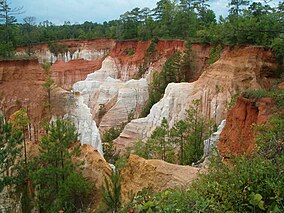Providence Canyon State Park
This article needs additional citations for verification. (September 2018) |
| Providence Canyon State Outdoor Recreation Area (Little Grand Canyon) | |
|---|---|
 Providence Canyon, from the rim | |
| Location | Stewart County, Georgia, US |
| Nearest city | Lumpkin, Georgia |
| Coordinates | 32°03′48″N 84°55′10″W / 32.063273°N 84.919511°W |
| Area | 1,003 acres (4.06 km2) |
| Elevation | 500 ft (150 m) |
| Established | 1971[1] |
| Operator | Georgia State Parks and Historic Sites |
Providence Canyon State Outdoor Recreation Area is a 1,003-acre (405.90 ha) Georgia state park located in Stewart County in southwest Georgia, United States.[2] The park contains Providence Canyon, which is sometimes called Georgia's "Little Grand Canyon". It is considered one of the Seven Natural Wonders of Georgia. It is also home to the very rare plumleaf azalea.
One of the more unusual attractions of the state park is an abandoned homestead including nearly a dozen rusty, 1950s-era cars and trucks. Due to the environmental damage that removing the vehicles would cause, park officials have decided to leave them alone.
Canyon formation
[edit]Providence Canyon is not actually a purely natural feature: many of the massive gullies — the deepest of which is more than 150 feet (46 m) — are the result of erosion due to poor farming practices in the 19th century.[3]
This story of the origin of the canyons has been commonplace since the 1940s, but the formations in the canyons are at least partially natural.[citation needed] Although there were probably a few early arrivals before 1825, the first heavy influx of settlers in Stewart County only came after the Treaty of Indian Springs (1825), by which the Creek Indians were forced to cede all their lands east of the Chattahoochee River. Evidence of the existence of the canyons at this time includes their mention in a deed by James S. Lunsford to William Tatam from 1836.[citation needed]
Geology
[edit]The park lies on marine sediments, usually loam or clay, with small areas of sand. Loamy sand topsoils overlie subsoils of sandy clay loam, sandy clay, or clay in most of the uneroded sections. Nankin, Cowarts, Mobila, and Orangeburg are the most prominent soil series. The canyons have significant exposure to clay, over which water often seeps. Water is mobile in this well-drained area.
Facilities
[edit]- 1,003 acres (406 ha)
- 2 picnic shelters
- 6 back country campsites
- 3 pioneer campsites
Yearly events
[edit]- Christmas Workshop (December)
- Astronomy Night (September)
- Fall Wildflower Day (October)
- Geology Day (October)
Images
[edit]-
Entrance sign
-
Providence Methodist Church
-
Interior of Providence Methodist Church
-
View from canyon rim
-
View from the canyon floor
-
Informational sign
See also
[edit]References
[edit]- ^ Krakow, Kenneth K. (1975). Georgia Place-Names: Their History and Origins (PDF). Macon, GA: Winship Press. p. 182. ISBN 0-915430-00-2.
- ^ "Providence Canyon State Outdoor Recreation Area Official Website". Retrieved June 22, 2021.
- ^ Sutter, Paul S. (2010). "What Gullies Mean: Georgia's 'Little Grand Canyon' and Southern Environmental History". Journal of Southern History. Vol. 76, no. 3. p. 579. Retrieved February 20, 2018.
Further reading
[edit]- Anonymous (n.d.). "Providence Canyon: Georgia State Parks and Historic Sites" (PDF) (Map). State Parks and Historic Sites. Cartersville: Georgia Department of Natural Resources. Retrieved February 16, 2013.
- Bieler, Kevin M. & Hyatt, James A. (2007). Defining Down-Valley Stratigraphic Records of Human Induced Canyons in Southwest Georgia (PDF). Willimantic: Department of Environmental Earth Science, Eastern Connecticut State University. Archived from the original (PDF) on September 12, 2013. Retrieved February 16, 2013.
- Coastal Living Editor (May 2, 2008). "A Tree Grows Through an Abandoned Truck at Providence Canyon State Park". Southern Living. Retrieved February 16, 2013.
{{cite news}}:|author=has generic name (help) - Hyatt, James A. (n.d.). Art and Science of Providence Canyon State Park in SW GA. Willimantic: Department of Environmental Earth Science, Eastern Connecticut State University. Archived from the original on January 28, 2012. Retrieved February 16, 2013.
- Nicoulin, Amberlee; Hyatt, James A. & Drzewiecki, Peter (2010). Comparison of Vibracore Records of Massive Human-Induced Erosion at Providence Canyon State Park in Southwest Georgia (PDF). Willimantic: Department of Environmental Earth Science, Eastern Connecticut State University. Archived from the original (PDF) on September 12, 2013. Retrieved February 16, 2013.
- Nicoulin, Amberlee; Hyatt, James A. & Drzewiecki, Peter (n.d.). Comparison of Vibracore Records of Massive Human-Induced Erosion at Providence Canyon State Park in Southwest Georgia (PDF) (Poster). Willimantic: Connecticut Science Center, Eastern Connecticut State University. Retrieved February 16, 2013.
- Ostrowski, Todd J. & Hyatt, James A. (2004). Research on Sedimentary Records of Human Induced Erosion in Stewart County, South Georgia (PDF). Willimantic: Department of Environmental Earth Science, Eastern Connecticut State University. Archived from the original (PDF) on September 11, 2013. Retrieved February 16, 2013.
- Sutter, Paul S. (2015). Let Us Now Praise Famous Gullies: Providence Canyon and the Soils of the South. Athens: University of Georgia Press.








